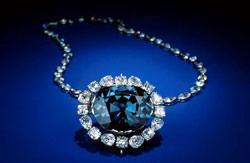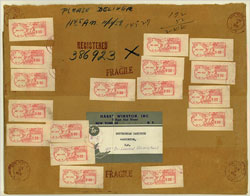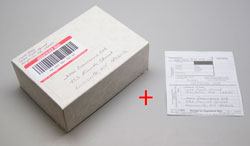How to mail a diamond
A gem packs a lot of value into a tiny space. Loss in transit would be an expensive nightmare.
But suppose you need to send a diamond to GIA for grading, or send damaged jewelry to a lab for repair. What's the best way to send gems and jewelry? What special precautions should you take to guarantee safe arrival of the package?
The answer is surprisingly easy: USPS insured registered mail.
This was the mode of transit used for the Hope Diamond, one of the most famous gems in the world. The Hope Diamond has gone on many travels in its long history. The original 112-carat stone dates back to the 17th century. King Louis XIV of France had it recut to a 67-carat gem that became known as the Blue Diamond of the Crown. It passed on through royal hands until the French Revolution, when Louis XVI and Marie Antoinette had to flee France. During a weeklong looting of the crown jewels, the celebrated diamond went missing.
In 1812, a diamond surfaced in London that seemed to be the recut French blue. King George IV of the U.K.acquired the stone. After his death it was apparently bought and sold a few times through private channels. Eventually it appeared in the collection of Henry Philip Hope, from whom it gets the name by which we know it today. Pierre Cartier bought the gem and resold it to an American heiress and socialite, who flamboyantly wore it for more than 30 years. After her death, the famous diamond was purchased by Harry Winston, Inc.
How all those previous transits took place we do not know. But in 1958, Harry Winston donated the Hope Diamond to the Smithsonian Institution. The way this luxury jeweler chose to send one of the most precious diamonds in the world to the Smithsonian was by U.S. postal service—insured registered mail.
Registered Mail
What makes Registered Mail so safe is that it provides an unbroken chain of custody. The package is kept in a sealed and locked container for its entire journey, and the shipment is registered at every step of the way.
The photo shows how the Hope Diamond package looked when it arrived at the Smithsonian in 1958. These days a tracking number allows the sender to check the package's whereabouts at any time.
Registered mail is considered so safe that the U.S. government allows it for sending classified material up to the "Secret" level. Information is classified Secret when its unauthorized disclosure would cause "serious damage" to national security. So if it's considered safe enough for our national security, it should be safe for our gems.
Packaging
Registered mail pretty much guarantees the jewelry's arrival, but it's up to the sender to prepare it against damage on route.
General instructions: The shipping box should be significantly larger than the jewelry—take your cue from the size box used to ship the Hope Diamond! Put the gem or jewelry in a small sealed plastic bag, such as a small zip-lock, and completely cushion it with enough bubble-wrap or similar filler to fill the box. The jewelry shouldn't be able to jostle around in transit. The contemporary shipping container shown is totally sealed with a tamper-proof taping system.
Sending the package registered and insured is a reliable way to transport the most valuable items.
FOR AGENTS AND UNDERWRITERS
All gems of significant value should have a lab report from a reliable lab, such as GIA.
If a client needs a lab report, suggest that she have her jeweler send the gem to the grading lab. A jeweler should know how to properly prepare the gem for shipping and should have the necessary "secure" packing materials required by the USPS for insured registered mail.
You can use the Hope Diamond story to help assure the client that insured registered mail is a very safe way for her own valuable gems and jewelry to be shipped.
FOR ADJUSTERS
If your company has a lab, the lab will know how to ship gems or jewelry and will have the appropriate packaging materials.
If the insurance company has no lab facilities, reach out to one of your trusted replacement sources whenever it's necessary to ship a gem or jewelry item.
©2000-2025, JCRS Inland Marine Solutions, Inc. All Rights Reserved. www.jcrs.com




